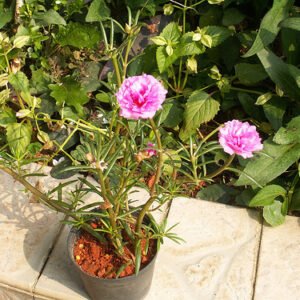Description
Pseudophoenix ekmanii (Cacheo,Cacheo de Oviedo,Dominican Cherry palm) is a palm species endemic to the Barahona Peninsula and Isla Beata in the Dominican Republic. It is a small tree, four to six metres tall, with pinnately compound leaves and solitary, swollen stems. The fruit are reddish with a diameter of about 2 centimetres in diameter.
Pseudophoenix ekmanii was used in the past of palm wine production. Trees were cut down and the pith extracted, especially from the swollen portion of the stem. Sap was extracted and fermented. As a consequence of this cutting for palm wine production, the species is considered critically endangered. Current threat include grazing and agriculture.
Description
An extremely distinctive, medium sized, solitary pinnate palm to about 5m tall with dark green, semi-glossy leaves to 2.5m long. They have a swollen stem, thickest towards the top, greyish-green in colour, with distinctive rings. The fruit are reddish with a diameter of about 2 centimetres in diameter.(S. Zona. 2002)/Palmweb.
Stem 5–6 m tall, strongly ventricose, most slender above the swelling, about 60 cm diameter breast high, with prominent brown leaf scars and waxy white internodes when young, gray when mature. Leaves about 12 in the crown, spreading (mature) or ascending (juvenile); leaf about 2–3 m long; sheath about 35 cm long, green with silvery gray scales near the apex; petiole absent; rachis about 161 cm long, often with brown scales along its margin; number of leaf segments per one side of the rachis not known; middle leaf segment 31.0–39.5 cm long, 1.7–2.3 cm wide, lanceolate with an acuminate tip, gray-green, densely glaucous on both sides, ramenta present on the abaxial surface of the midvein at the base of the leaf segment. Inflorescence erect, ascending or arching, branched to 3 orders, about 154 cm long; peduncle not extending far beyond the leaf sheaths, glabrous; prophyll not seen; inner bract not seen; rachillae 5.9–8.0 cm long and 0.8–0.9 mm in diam., divaricating. Flower pseudopedicel 7.2–7.6 mm long, 0.4–0.5 mm in diam., green to glaucous; calyx a shallow triangular cupule, 3.5–3.8 mm in diam., green to glaucous, margins hyaline; petals ovate, about 7.0 mm long and 3.7 mm wide, green, glaucous abaxially, spreading, with about 13 major veins; filaments 1.3–1.7 mm long, briefly connate, anthers ovoid, about 2.8 mm long, about 1.5 mm wide, yellow; gynoecium and pistillode not seen. Fruit 11.8–14.3 mm long, 11.7–13.2 mm in diam. (in single-seeded fruits); endocarp 11.7–13.2 mm long, 11.1–12.6 mm in diam., about 0.2 mm thick. Seed 6.8–7.1 mm long, 8.5–9.4 mm in diam. (S. Zona. 2002)/Palmweb. Editing by edric.
This poorly known species is perhaps the most beautiful of all the Pseudophoenix. As juveniles, the trunks are waxy white with brown nodes and the leaves are gray and stiff. At maturity, the stems become strongly ventricose to bottle-shaped. They are striking palms. Pseudophoenix ekmanii resembles P. vinifera, in that they both have strongly ventricose trunks. Unlike that of P. vinifera, the trunk of P. ekmanii has waxy white internodes when young. Pseudophoenix ekmanii has a divaricating inflorescence and smaller fruits (<13.2 mm in diam.), whereas the inflorescence of P. vinifera has distally directed branches and the fruits are larger (16.2–22.2 mm in diam.). At any stage, P. ekmanii is easily distinguished from any other species by its absence of a petiole, that is to say, there is no obvious petiole between the sheathing leaf base and the leafy rachis. Read (1968) reported that the stamen filaments are short (less than 1.5 mm long), but his observation was made from immature flower buds. The filament length reported here is based on the persistent filaments of the immature fruits of Zanoni et al. 36100. (S. Zona. 2002)/Palmweb.
Culture
Sunny, moist, but well drained position. Prefers a limestone based soil. Very slow growing. Cold Hardiness Zone: 9b.
They are maybe one of the slowest palms in the world for the first 15 or so years… but the next 15 years, this palm explodes! When this palm finally gets some resources to work with, it really speeds up. (Andrew Street)
Comments and Curiosities
Etymology: The specific epithet, Honors the early 20th century Swedish botanist, Erik Ekman, who worked extensively in the Caribbean area.
Conservation: Although virtually the entire population of Pseudophoenix ekmanii occurs in a national park, the palm is still harvested for its sweet sap which is fermented into alcohol. Decapitated juveniles attest to the activities of sap poachers. In addition, seed harvesting, if excessive, may threaten the reproductive health of the population. (S. Zona. 2002)/Palmweb.
Uses: The sap is used for palm wine production, which usually results in the death of the tree, and the seeds are collected for stock feed.
Delivery: With in one day
Any questions, feel free contact us:







Reviews
There are no reviews yet.